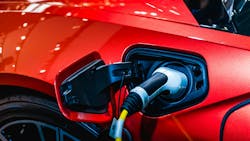Assessing the Impact of Cutting Electric Vehicle Tax Credits
Construction contracting and design firms that smelled opportunity in a budding U.S. electric vehicle and infrastructure revolution are now getting a whiff of brewing trouble in the wake of a major shift in electric vehicle (EV) tax policy.
The recently passed One Big Beautiful Bill of tax and spending measures ends generous federal tax credits that have helped spur EV sales and battery charger installations, continuing a broad Trump administration pushback on EVs that began in January.
Gone as of Sept. 30, 2025 is a $7,500 federal tax credit for buying or leasing new EVs and a $4,000 credit for used vehicles. Also, a 30% credit for installing battery chargers for residences and businesses is slated to end June 30, 2026. Both are ending well ahead of their initial phase-outs.
Coupled with executive orders scaling back the National Electric Vehicle Infrastructure (NEVI) program and other EV boosters in the Inflation Reduction Act and the Infrastructure Investment and Jobs Act, the end of tax credits could slow or stall EV adoption. That could ripple out, negatively impacting construction, improvement, and retooling of the infrastructure taking shape around the promise of electrified transportation: vehicle and battery manufacturing plants, charging stations, the electrical grid, and even data centers.
The growing promise of EVs has given the current generation of builders another bite of the apple — an opportunity to profit off a reincarnation of the same dynamic U.S. auto culture that was a major driver of 20th-century economic growth. A January report by the Environmental Defense Fund found that by year end 2024, a decade of investments in EV and EV battery manufacturing facilities totaled almost $198 billion. Without the incentives that have helped lift EVs so far, though, that payoff might be delayed, or worst case, never realized.
A March 2025 report from the Salata Institute for Climate and Sustainability at Harvard University details cause for concern.
Looking at various incentives in isolation or combination, the policy brief calculates their loss will reduce the number of EVs on the road (see Figure). Without the $7,500 credit, EVs as a share of new light-duty vehicle sales in 2030 will be 6% less than the 48% forecast by market watcher Bloomberg New Energy Finance prior to the 2024 general election. Cutting that credit would have the single biggest negative impact. Eliminating other support programs would cut deeper; axing the 30C charger credit, the vehicle credit and various supports through the NEVI would double the hit. If a half-dozen key supports it identified were all cut, the 2030 forecast would be reduced by 16%.
“The effect of these policies (to cut incentives) is to postpone EV adoption in the United States by two to three years,” the authors write.
The broad policy shift — and the expectations for it — may be curbing EV charger installations. As reported in a Transport Topics story in May Bloomberg, NEF sees evidence of a 21% year-over-year (YOY) drop in U.S. charger installations in the first quarter of 2025, due in large part to mounting uncertainty about EV growth. Bloomberg reportedly forecasts a 20% drop in total new charger installations this year, to 285,000. And, if anti-EV policy trends take firm root, Bloomberg sees the potential for 30% annual declines in charger installations through 2030.
A pullback in charger installations could compound the effect of the tax credit phaseout on EV penetration. A perceived dearth of charging stations across the country, especially those with fast chargers, has helped stunt EV sales as drivers express “range anxiety,” shorthand for worries about being stranded on the road with a dead car battery. That, of course, feeds on itself: Chargers need EVs, and EVs need chargers.
Another new EV research project bolsters the view that a robust charging network is vital to the future of EVs, more so than tax incentives. Based on a study of EV adoption in Washington state, a Carnegie Mellon business school professor has found evidence that more chargers might do more than tax credits to entice drivers to buy EVs. A story on the research says the findings “upend the debate over EV incentives, suggesting that the key to widespread adoption may lie not in bigger tax credits but in better infrastructure.”
But however impacts might be allocated, there’s little doubt that the EV market has benefitted from incentives, and that removing them could deliver at least a short-term shock. And shocks, of course, can paralyze, perhaps taking the wind out of the sails of an emerging market some developers and builders have made bets on.
About the Author
Tom Zind
Freelance Writer
Zind is a freelance writer based in Lee’s Summit, Mo. He can be reached at [email protected].

